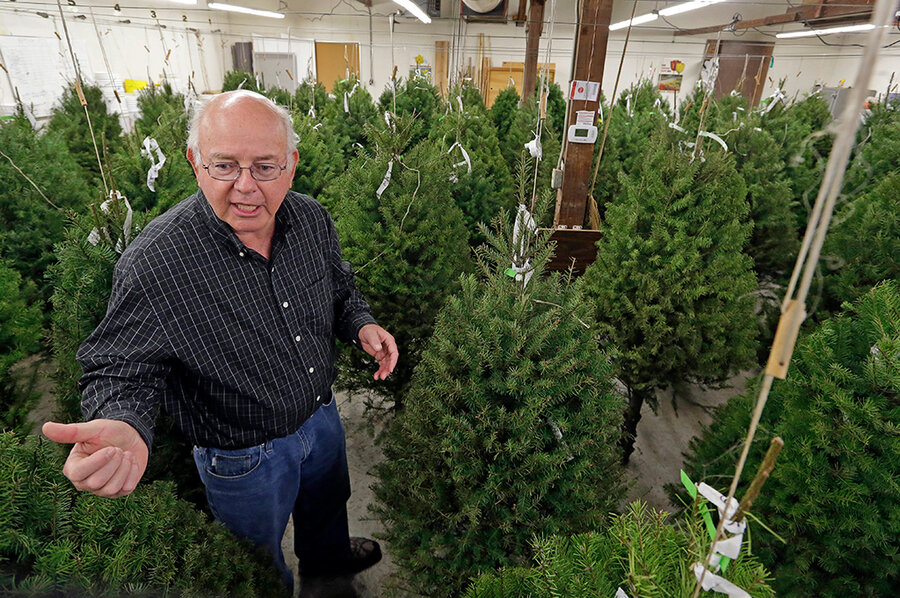Needling question: Can science create a perfect Christmas tree?
Loading...
| Toronto
They call him Dr. Christmas Tree. When a reporter once dubbed him the scientific Santa Claus, he just laughed – jovially, of course.
Gary Chastagner, a plant pathologist at Washington State University in Pullman, has spent four decades using science to try to engineer the perfect Christmas tree – an evergreen with fullness, beautiful hue, and most important to consumers, needles that last through the holidays.
At this time of year, tree farms and retail lots are packed with patrons hoping to purchase the ideal conifer. Little do they know that first, in laboratories from Nova Scotia to North Carolina, tree scientists and geneticists have been working tirelessly to ensure that consumers aren’t dependent on the handiwork of nature. Researchers are battling pests, discovering the dryness threshold for harvested trees, and identifying new species for people’s living rooms.
On a recent day, I watch Dr. Chastagner by video as he wanders around one of his lab rooms, where branches from 3,600 trees sit in neat racks. He picks up one, a sorry-looking limb, nearly bare. He pulls up another and rubs it between his fingers: None of its needles falls. His team gives each stem a score and records it, with the aim of eventually identifying and re-creating as perfect a tree as possible.
The work is part of one of the most ambitious projects of Yuletide greenery underway in the world. Dr. Chastagner, along with growers and academic colleagues from about a dozen institutions in the United States and Denmark, are studying the ability of new species – including two types of fir trees native to Turkey – to adapt to conditions in North America.
The project is dubbed CoFirGe, for Collaborative Fir Germplasm Evaluation, and it started a decade ago from international cooperation forged by academics and growers, who had been long dealing with tree diseases and needle loss in isolation. They wanted to start sharing information. The project drew on research in North Carolina and Washington state about root rot, a fungal-like disease that limits where Fraser and noble fir can be grown. They found that the Turkish trees were resistant to it.
Dr. Chastagner and colleagues traveled to the country to collect cones from different forests with Turkish and Trojan fir. Back home, they grew seedlings and shipped them to collaborators who planted them in five different regions of North America – 36,000 trees in all. The researchers have been doing post-harvest work for the past three years, with an eye toward establishing alternative trees that could one day become household names like Douglas or balsam fir.
This isn’t the only project aimed at creating a better Christmas tree. The U.S.-based Christmas Tree Promotion Board has recently funded research into topics as varied as slug management, cone formation, and control of the twig weevil – a notorious pest.
Bert Cregg, a Christmas tree expert at Michigan State University in East Lansing, says all are annoyances that consumers don’t notice but can wreak havoc for growers. One example: the cones of a typical Fraser fir grown in Michigan.
“It is actually a negative thing,” he says. “Instead of making needles and branches, it is making these cones. And so it affects the appearance of the tree. The growers actually pick the cones in the spring when they first appear. And it’s a huge labor issue.”
In Nova Scotia, Dalhousie University has generated headlines in recent years for its SMART tree, short for the cumbersome senescence modulated abscission regulated technologies. This project uses selective breeding to improve balsam fir, the species that dominates Christmas tree sales in eastern Canada. Balsam fir smells nice but sheds needles more easily than other trees.
“The idea is to try to develop through genetics and selection ... trees that will have the balsam characteristic smell and look and everything, but that will retain their needles,” says Dr. Cregg.
None of this is going to happen overnight. Dr. Chastagner used to study full-size Christmas trees in his lab but now works with branches, a technique he established as a predictor of the mother tree. With this approach, researchers can examine the characteristics of more trees over many years, allowing them to account for weather variations and other factors. This helps them study the effects of climate change – how species adapt to early- or late-arriving growing seasons.
They can also use data about needle loss to identify superior trees in a plantation. Growers will then collect shoots, graft them onto rootstock, and grow trees that eventually produce seeds – in 20 to 25 years. Then it takes another decade to grow a mature tree. In other words, the process is slow.
So those hoping to display the perfect tree this Christmas may want to heed the advice of Dr. Chastagner: Grab a water bucket.
“The single most important thing that a consumer can do to minimize needle shedding and improve the quality of the tree is to make sure that they properly display the tree in a water-holding stand,” he says.








